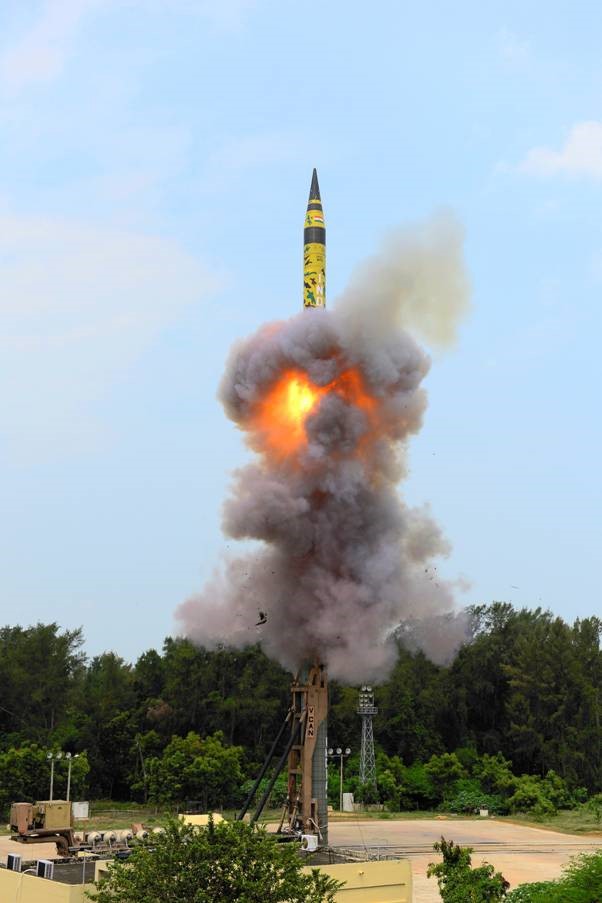Description
 Disclaimer: Copyright infringement not intended
Disclaimer: Copyright infringement not intended
Context:
New Generation Ballistic Missile ‘Agni Prime’ was successfully flight-tested by Defence Research and Development Organisation (DRDO) from Dr APJ Abdul Kalam Island off the coast of Odisha.
More about the News:
- This was the first pre-induction night launch conducted by the Tri-services strategic forces command, which handles the country's nuclear arsenal, after three successful developmental trials of the missile.
- It validated the accuracy and reliability of the system.
- all objectives were successfully demonstrated in the test.
- This missile will gradually replace the Agni-I(700) ballistic missile.
About the Agni prime ballistic missile:
- It is a new-generation nuclear capable ballistic missile.
- It has a strike range of 1000-2000 Kms.
- The missile incorporates advanced features such as a new propulsion system and composite rocket motor casings.
- It is also a canister launch missile like country’s first Intercontinental Ballistic Missile(ICBM), Agni-V, which is in the process of induction. By SFC.
- Canister launch missiles with the warhead already fitted in the missile gives the command operational flexibility to store it for a longer period.
- This makes it easier for the missile to be swiftly moved using rails, trucks or any other vehicles and can be fired from any platform.
.jpeg)
Indian Ballistic Missile Defence Programme:
- The Indian Ballistic Missile Defence Program is an initiative to develop and deploy a multi-layered ballistic missile defence system to protect India from ballistic missile attacks.
- It was launched in 2000 after the Kargil War by the Atal Bihari Vajpayee government.
- It was Introduced in light of the ballistic missile threat from Pakistan and China.
- It is a double-tiered system consisting of two land and sea-based interceptor missiles, namely the Prithvi Air Defence (PAD) missile for high altitude interception, and the Advanced Air Defence (AAD) Missile for lower altitude interception.
- The work for its development started with two phases. Phase 1 has been successfully tested and completed and deployment awaits final official permission. Phase 2 is under development.
- Phase 1 focuses on intercepting missiles with a range of upto 2000 km (basically focusing Pakistan’s missile arsenal). It includes three defence mechanisms PRITHVI AIR DEFENCE (PAD), ADVANCED AIR DEFENCE (AAD) and SWORDFISH RADAR.
- Phase 2 will be capable of Intercepting missiles upto 5000 km and it is under development.
- The PAD was tested in November 2006, followed by the AAD in December 2007.
- With the test of the PAD missile, India became the fourth country to have successfully developed an anti-ballistic missile system, after the United States, Russia, and Israel.
PRITHVI AIR DEFENCE (PAD)
- This missile is an EXO-Atmospheric Anti-Ballistic missile, which implies that it can intercept a missile out in the atmosphere, with a Flight Altitude of 80 Km and Range from 300 to 2000 km.
- It has a two stage rocket booster with first stage: Dual propellant liquid fuel and oxidizer and second solid fuel.
- It has a Maximum speed of Mach 5-8.
ADVANCED AIR DEFENCE (AAD)
- This is an Endo atmospheric Anti-Ballistic missile and can intercept and destroy a target in the lower atmospheric layer.
- It’s a single stage solid fueled missile with a maximum range from 150 to 200 km and Maximum altitude of interception range is 30 km.
- Its Maximum speed is nearly about 4.5 Mach
PRITHVI DEFENCE VEHICLE
- This missile is also an EXO-Atmospheric Anti-Ballistic missile. It means it can intercept a missile out in the atmosphere
- It has the same range as PAD (300- 2000 km) but its Flight Altitude is enhanced to 150 km with a more accurate Guidance system using Ring Laser Gyro based inertial navigation system.
PRITHVI DEFENCE VEHICLE Mk-2 or ASAT
- This missile is an EXO-Atmospheric Anti-Ballistic missile and can intercept a missile/satellite out in orbit.
- With a Maximum Flight Altitude of 1200 km.
- It has a two stage rocket motor with a third stage added as a kinetic kill vehicle.
- It was In 2019 that ASAT was successfully tested by destroying one of India’s
SWORDFISH RADAR
- Swordfish is an active electronically scanned array (AESA) long range tracking radar
- It is based on Israeli EL/M-2080 Green Pine long range radar and it works on L Band frequency.
- It is made by Bharat Electronics Limited and Electronics & Radar Development Establishment
- It has a range of 1500 km and can track upto 200 targets with maximum speed of Mach 12.
- It can even track targets upto 3 inch in diameter.

Conclusion:
By keeping in mind a motto of “No first use policy” and “Minimum Credible deterrence” India needs to build an adequate defence mechanism to counter the future threats from the hostile neighbouring countries. Agni Prime along with Agni-V would prove to be a strong deference against China and Pakistan.
|
PRACTICE QUESTION
Q) Consider the following statements about Agni Prime
- It is the new generation cruise missile of DRDO having a strike range of 1000-2000 Km.
- It will replace Agni-V ballistic missile from the arsenal.
Which of the above statements is/are incorrect?
- 1 only
- 2 only
- Both 1 and 2
- Neither 1 nor 2
Ans: 3
|
https://pib.gov.in/PressReleasePage.aspx?PRID=1930689
https://indiancc.mygov.in/wp-content/uploads/2021/06/mygov-1000000000504859806.pdf





 Disclaimer: Copyright infringement not intended
Disclaimer: Copyright infringement not intended









